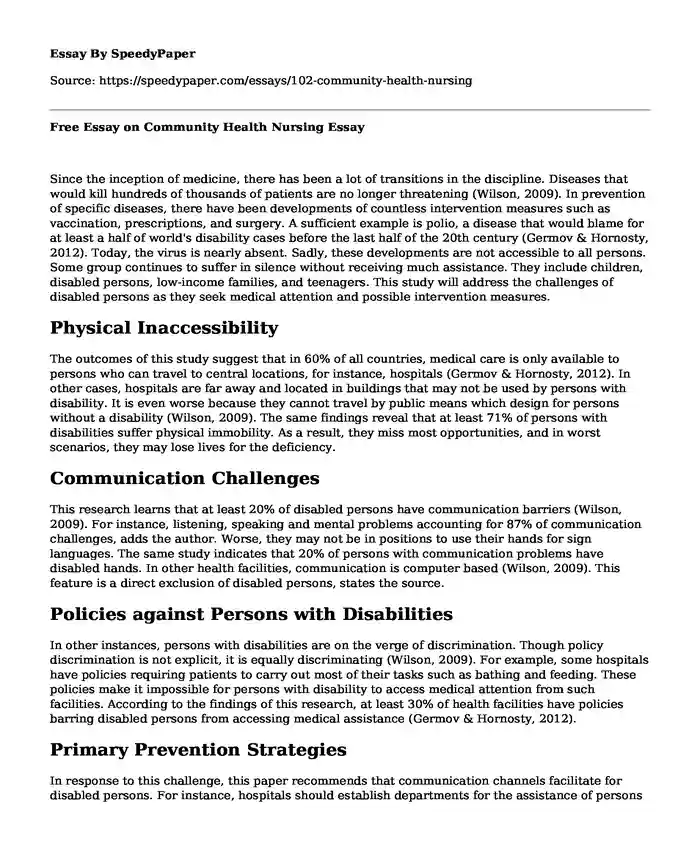
| Type of paper: | Essay |
| Categories: | Nursing Medicine Society Community health |
| Pages: | 3 |
| Wordcount: | 600 words |
Since the inception of medicine, there has been a lot of transitions in the discipline. Diseases that would kill hundreds of thousands of patients are no longer threatening (Wilson, 2009). In prevention of specific diseases, there have been developments of countless intervention measures such as vaccination, prescriptions, and surgery. A sufficient example is polio, a disease that would blame for at least a half of world's disability cases before the last half of the 20th century (Germov & Hornosty, 2012). Today, the virus is nearly absent. Sadly, these developments are not accessible to all persons. Some group continues to suffer in silence without receiving much assistance. They include children, disabled persons, low-income families, and teenagers. This study will address the challenges of disabled persons as they seek medical attention and possible intervention measures.
Physical Inaccessibility
The outcomes of this study suggest that in 60% of all countries, medical care is only available to persons who can travel to central locations, for instance, hospitals (Germov & Hornosty, 2012). In other cases, hospitals are far away and located in buildings that may not be used by persons with disability. It is even worse because they cannot travel by public means which design for persons without a disability (Wilson, 2009). The same findings reveal that at least 71% of persons with disabilities suffer physical immobility. As a result, they miss most opportunities, and in worst scenarios, they may lose lives for the deficiency.
Communication Challenges
This research learns that at least 20% of disabled persons have communication barriers (Wilson, 2009). For instance, listening, speaking and mental problems accounting for 87% of communication challenges, adds the author. Worse, they may not be in positions to use their hands for sign languages. The same study indicates that 20% of persons with communication problems have disabled hands. In other health facilities, communication is computer based (Wilson, 2009). This feature is a direct exclusion of disabled persons, states the source.
Policies against Persons with Disabilities
In other instances, persons with disabilities are on the verge of discrimination. Though policy discrimination is not explicit, it is equally discriminating (Wilson, 2009). For example, some hospitals have policies requiring patients to carry out most of their tasks such as bathing and feeding. These policies make it impossible for persons with disability to access medical attention from such facilities. According to the findings of this research, at least 30% of health facilities have policies barring disabled persons from accessing medical assistance (Germov & Hornosty, 2012).
Primary Prevention Strategies
In response to this challenge, this paper recommends that communication channels facilitate for disabled persons. For instance, hospitals should establish departments for the assistance of persons with disabilities. Similarly, they should provide mobility for disabled persons. For example, by providing wheelchairs and ambulances. Also, they should design their buildings in ways that are friendly to them, for example by providing lifts. Moreover, they should ensure representation of these persons in meetings and hospital decisions.
Summary
Conclusively, this research learns that though many people can access medical care, certain groups, for instance, people with disabilities are left out. The primary reasons for their exclusion range from communication barriers, immobility, and inconsiderate policies. However, this study appreciates that these deficiencies are addressable. Strategies suggested for addressing them include facilitating communication channels for disabled persons, the establishment of departments in hospitals for persons with disabilities and ensuring mobility through wheelchairs and ambulances. Additionally, hospitals may restructure their buildings to accommodate them.
References
Wilson, D. (2009). Polio (1st ed.). Santa Barbara, Calif.: Greenwood Press/ABC-CLIO.
Germov, J., and Hornosty, J. (2012). Second Opinion: An Introduction to Health Sociology, Canadian Edition. Don Mills: Oxford University Press.
Cite this page
Free Essay on Community Health Nursing. (2018, Feb 28). Retrieved from https://speedypaper.net/essays/102-community-health-nursing
Request Removal
If you are the original author of this essay and no longer wish to have it published on the SpeedyPaper website, please click below to request its removal:
- Free Essay Sample on Spiritual Needs Assessment
- What Is the Definition of Love - Essay Example
- Essay Sample on Cultural Exploration: Madrid, Spain
- Essay Sample on the Difference between Native and Settler Relations to Land
- Essay Example on How Family Violence Is Related to Child Abuse and Maltreatment
- Essay Example on Changing Families in the United States of America
- Free Essay. Women Abuse During the 19th Century in "Oliver Twist" and "Hard Times."
Popular categories




